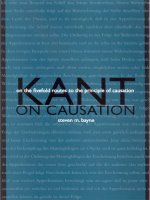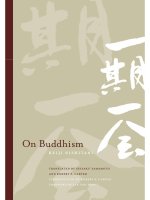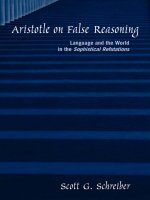state university of new york press oppenheimers choice reflections from moral philosophy jul 2006
Bạn đang xem bản rút gọn của tài liệu. Xem và tải ngay bản đầy đủ của tài liệu tại đây (1021.24 KB, 197 trang )
OPPENHEIMER’S
CHOICE
Refl ections from
Moral Philosophy
RICHARD MASON
OPPENHEIMER’S
CHOICE
SUNY SERIES IN PHILOSOPHY
George R. Lucas, Jr., editor
OPPENHEIMER’S
CHOICE
Reections from Moral Philosophy
RICHARD MASON
State University of New York Press
Published by
STATE UNIVERSITY OF NEW YORK PRESS,
Albany
© 2006 State University of New York
All rights reserved
Printed in the United States of America
No part of this book may be used or reproduced in any manner whatsoever without written
permission. No part of this book may be stored in a retrieval system or transmitted in any
form or by any means including electronic, electrostatic, magnetic tape, mechanical,
photocopying, recording, or otherwise without the prior permission in writing of the
publisher.
For information, address State University of New York Press
194 Washington Avenue, Suite 305, Albany, NY 12210-2384
Production, Laurie Searl
Marketing, Michael Campochiaro
Library of Congress Cataloging-in-Publication Data
Mason, Richard, 1948-
Oppenheimer’s choice : reflections from moral philosophy / Richard Mason.
p. cm. — (SUNY series in philosophy)
Includes bibliographical references (p. ) and index.
ISBN 0-7914-6781-3 (hardcover : alk. paper)
1. Technology—Moral and ethical aspects. 2. Ethics. 3. Oppenheimer, J. Robert, 1904-
1967. I. Title. II. Series.
BJ59.M38 2006
170—dc22
2005020545
10987654321
To Eline Tolstoy and Maya Tolstoy, scientists
This page intentionally left blank.
Moral philosophy has, indeed, this peculiar disadvantage, which is not
found in natural, that in collecting its experiments, it cannot make
them purposely, with premeditation, and after such a manner as to
satisfy itself concerning every particular which may arise. When I am
at a loss to know the effects of one body upon another in any situation,
I need only put them in that situation, and observe what results from
it. But shou’d I endeavour to clear up after the same manner any doubt
in moral philosophy, by placing myself in the same case with that
which I consider, ’tis evident this reflection and premeditation wou’d so
disturb the operation of my natural principles, as must render it impos-
sible to form any just conclusion from the phænomenon. We must
therefore glean up our experiments in this science from a cautious
observation of human life, and take them as they appear in the com-
mon course of the world, by men’s behaviour in company, in affairs, and
in their pleasures. Where experiments of this kind are judiciously col-
lected and compar’d, we may hope to establish on them a science,
which will not be inferior in certainty, and will be much superior in
utility to any other of human comprehension.
—Hume, A Treatise of Human Nature, Book I, Introduction
This page intentionally left blank.
CONTENTS
Introduction 1
Chapter 1 The Value in a Story 13
Chapter 2 A Point of Choice? 23
Chapter 3 One Large Fact 39
Chapter 4 Curiosity 55
Chapter 5 Responsibility 71
Chapter 6 Irreversible Change 93
Chapter 7 Purity 117
Chapter 8 The Lessons of History 135
Notes 161
References 173
Index of Names 181
This page intentionally left blank.
INTRODUCTION
The aim of this book is to reect on a course in life taken by one
man—Robert Oppenheimer—and, more particularly, his choice to
accept the leadership of research and development at Los Alamos
between 1942 and 1945, which resulted in the production and use of
the rst atomic bombs.
The bare external facts of Oppenheimer’s life can be stated straight-
forwardly.
He was born in New York City in 1904. His parents were Jewish;
his father a rst-generation immigrant from Germany, his mother from
a family settled for some time in Baltimore. His father had prospered in
business. The family was wealthy. Oppenheimer attended the Ethical
Culture School from 1911 to 1921. After studies and research at Harvard,
Cambridge, and Göttingen, and some postdoctoral work elsewhere, he
settled into appointments at Berkeley and Caltech. He made a steady
contribution to research in physics during the 1930s. By the early 1940s,
he moved closer to the initial stages of the U.S. government’s atomic
program—later to be known as the Manhattan Project—and by the
winter of 1942–1943 he had been appointed director of the research
laboratory to be built at Los Alamos. The rst atomic bomb was tested
at Alamogordo on July 16, 1945: “Trinity.” A uranium bomb was dropped
on Hiroshima on August 6; a plutonium bomb on Nagasaki on August
9. The war ended six days later. Oppenheimer left Los Alamos in
October 1945. After periods at Caltech and Berkeley, he became Direc-
tor of the Institute for Advanced Study at Princeton. He served the
Atomic Energy Commission in central advisory and consultative roles
until 1954, when his security clearance was removed after hearings
before the commission’s Personnel Security Board. Oppenheimer re-
mained at Princeton until shortly before his death in 1967. His security
clearance was never reinstated.
A less impersonal narrative hardly needs to be more detailed.
Oppenheimer was widely known as a reective physicist. In his
Princeton years he became a famous polymath. Some found him too
1
2 OPPENHEIMER’S CHOICE
reective, dispersing his talents too widely for genuine creativity in a
specialized and competitive eld. His many public pronouncements
after 1945 were thoughtful, well-informed, and perceptive. But it is
not as an original thinker or writer that we look to him now. He
remains interesting because he did what he did with his eyes open,
and not because he left us any intellectualized record of strenuous
decision-making. At the security hearings in 1954 there was a gruel-
ing interrogation of his motives and intentions in the early 1940s, but
such retrospective analysis, especially in such a fraught context, must
be treated with caution. Even the debates among atomic scientists in
the late 1940s, before the worst Cold War paranoia took hold, were
more openly reective, in very different circumstances, than whatever
went through the minds of Oppenheimer and his colleagues from
1942 to 1944, when the priority was action, not words.
1
There are excellent studies of Oppenheimer’s contribution at
Los Alamos and of his later security problems. His later conclusions
on atomic weapons have been subjected to much scrutiny, some of it
sharply critical.
2
This book will reect on how he came to work on
the bomb, what this meant and what it means now. So the aim is not
biographical and it is not psychological. There will be no startling
revelations and there will be no speculations on conscious or uncon-
scious motives. One of the advantages in dealing with Oppenheimer
is that we do not have to wrestle with soul-searching or hesitation.
His decision in 1942 is not of interest because it felt a difcult one for
him. On the contrary, he moved swiftly into his work on the bomb
and pursued it with single-minded zeal. There were many doubts among
those who worked at Los Alamos, particularly as the war in Europe
was ending, but he drove on to the conclusion. We need to ponder
the outcome of his initial choices, his subsequent actions and their
context, not a record of his thoughts.
࣎
Oppenheimer himself claimed that the atomic project was a technical
challenge, rather than a problem in pure science. That was both
modest and misleading. For now, it is worth noting that his later
wartime contribution went well beyond the building of the bomb, and
into its use. From his security hearings:
ROBB: In fact, Doctor, you testied, did you not, that you assisted in
selecting the target for the drop of the bomb on Japan?
3INTRODUCTION
OPPENHEIMER: Right.
ROBB: You knew, did you not, that the dropping of that atomic
bomb on the target you had selected will kill or injure thousands of
civilians, is that correct?
OPPENHEIMER: Not as many as turned out.
ROBB: How many were killed or injured?
OPPENHEIMER: 70,000.
ROBB: Did you have moral scruples about that?
OPPENHEIMER: Terrible ones.
ROBB: But you testied the other day, did you not, sir, that the
bombing of Hiroshima was very successful?
OPPENHEIMER: Well, it was technically successful.
ROBB: Oh, technically.
OPPENHEIMER: It is also alleged to have helped end the war.
3
The responsibility for the use of the rst atomic bombs in 1945, and
the selection of targets, was diffuse. The drive behind the creation of
the rst bombs was surprisingly narrow. General Leslie R. Groves,
who knew better than anyone, as the military head of the entire
project, spoke frankly at the 1954 hearings:
GARRISON: You appointed Dr. Oppenheimer to be the director of
the work at Los Alamos?
GROVES: Yes, sir.
GARRISON: You devolved great responsibility upon him?
GROVES: Yes.
GARRISON: Would you just say a word about the nature of that
responsibility?
4 OPPENHEIMER’S CHOICE
GROVES: Complete responsibility for the operation of Los Alamos
Laboratory, the mission of which was to carry on the research neces-
sary to develop the design of a bomb, to develop the probabilities of
whether a bomb was possible, and if the design would be feasible, and
to develop what the power of the bomb would be. . . .
GARRISON: How would you rate the quality of his achievement as
you look back on it?
GROVES: Naturally I am prejudiced, because I selected him for the
job, but I think he did a magnicent job as far as the war effort was
concerned . . .
4
Groves concluded in his memoirs that the United States could only
have produced the atomic bomb in time of war “because of the great
costs and difculties involved and the apparently very small chance of
success.” The project had employed 600,000 people on the tightest of
deadlines. No one can say that it would not have succeeded without
Oppenheimer. We can say that it would not have worked as and
when it did without him; and that is to say a great deal. “I have never
felt that it was a mistake to have selected and cleared Oppenheimer
for his wartime post,” wrote Groves, “he accomplished his assigned
mission and he did it well. We will never know whether anyone else
could have done it better or even as well. I do not think so, and this
opinion is almost universal among those who were familiar with the
wartime operations at Los Alamos.”
5
࣎
But why a book like this about Oppenheimer?
His choice in 1942, and his work from then until 1945, repre-
sents something of permanent importance. The Manhattan Project
was the rst huge scientic-military-industrial-nancial undertaking,
with obviously large consequences. Oppenheimer mattered in a way
that most people do not matter. His choices and actions made a
difference to the world. This may be how it is for some people, but
for most it is not so and never will be. That sounds uncomfortable,
but it leads to some central problems discussed in this book: about the
particular place of a scientist in society—problems about responsibil-
ity, the place of curiosity, about the relation between theory and
practice. A notion of specialized scientic ethics seems at the same
5INTRODUCTION
time repugnant and absolutely necessary. Oppenheimer’s choice leads
to questions about corporate action and responsibility that still face
scientists today and can only become more acute. A large technical
and industrial project with an equally intricate political superstructure
could never be the responsibility of one person. What does this mean
for choice, guilt, blame, and conscience? Are these concepts simply
left over from an older, simpler world?
Much has been written about the Holocaust in Europe, where
responsibility may be pinned on people of undeniable evil who lost a
war. Whatever the intentions of political leaders in wartime, most of
those who take part in wars, and who suffer the consequences, are
motivated less by malice or hatred than by patriotism, solidarity, or
some feeling for self-protection. In the future, it seems far less probable
that an important industrial power will fall under the spell of a malevo-
lent dictator than that wars may start as a result of misalliances, con-
fusion, or political misunderstanding. The creation of atomic weapons
was the responsibility of people in a free society whose initial intentions
could hardly be seen as evil, yet the consequences for Hiroshima and
Nagasaki were as dreadful as any of the destruction during the war in
Europe. How this came about, especially in its rst steps, merits some
careful thought.
Freedom of choice, in a free society, is relevant. The case of
Werner Heisenberg in Nazi Germany, in contrast, raises its own ques-
tions. Heisenberg chose not to leave his country and to work with
some degree of commitment on the development of atomic weapons
in time of war. Not surprisingly, the exact degree of his commitment
and the reasons for his actions have been the subjects of the most
detailed debate.
6
In the Soviet Union, Andrei Sakharov followed some
way along Oppenheimer’s path through the development of nuclear
weapons, and later went far further in his repudiation of the bomb, at
the greatest personal cost. In his memoirs he noted tersely: “In 1948,
no one asked whether or not I wanted to take part in such work. I had
no real choice in the matter.”
7
In contrast, Oppenheimer’s choice is
of particular interest because it was unforced. He could have refused
Groves’s offer to lead the project. He could have taken some con-
tributory part, or no part at all. This might have been true of
Heisenberg, too. Maybe he could have assumed no part in German
atomic research or he could have lied about its practicability at no
loss or danger to himself; but in his case the uncertainties are com-
plicating. If Sakharov had tried to refuse the role offered to him in
6 OPPENHEIMER’S CHOICE
1948, most probably he would have been shot. Oppenheimer could
never have wanted to claim that he had to do what he did. Nor—as
with Groves, for example, as a serving military ofcer, (I. I. Rabi
called him “that eccentric administrative genius”
8
), was it any part of
his dened or expected duty. If there is unconstrained choice, it was
Oppenheimer’s. To say this is not to beg any question about the
innocuousness of American politics in the 1940s in contrast with
Germany in the 1930s or the Soviet Union in the 1950s; and of
course there was some social and political context of wartime, patri-
otic duty, expectation, and persuasion. It is only to note that what-
ever the considerations for Oppenheimer in 1942, we can be sure that
political pressure (and still less overt coercion) was not among them.
By the late 1940s, the story was darker and far more complicated.
Oppenheimer among others came to be interrogated on the degree of
his enthusiasm for the development of the hydrogen bomb, as a bench-
mark for loyal anticommunism. In 1942, the picture had been clearer.
࣎
In the 1940s, Adorno and Horkheimer argued that the authoritarianism
of Nazi Germany was an outcome of enlightenment ideology.
9
It has
crossed many minds that the atomic bomb also represents some end point
in Western culture, either as a logical result of scientic positivism, or
as its reductio ad absurdum, or perhaps just as a full stop to Enlighten-
ment optimism. Oppenheimer himself mused: “The real impact of the
creation of the atomic bomb and atomic weapons—to understand that
one has to look further back.”
10
Although he spent no time on record-
ing reections at Los Alamos, it was obvious throughout that he under-
stood was he was doing in the widest context.
The rst full history of the Manhattan Project was written by a
philosopher, David Hawkins, who worked at Oppenheimer’s side as an
administrator: Manhattan District History: Project Y: The Los Alamos
Project.
11
Many of the questions raised by Oppenheimer’s work have
been posed in biographical or historical studies. This book aims to
sort out those questions and offer some answers.
To clear the ground, chapter 1, The Value in a Story, begins by
questioning the point of the whole exercise. How far can a single life
at a single time tell us anything general, applicable beyond itself and
its own circumstances? What could Oppenheimer represent, beyond
himself? Why not think more generally about The Scientist? Or to
7INTRODUCTION
put the same point in another way, what is the relation between
biography and philosophy, or moral philosophy? Or, in still another
way, what is the relation between the individual case and the univer-
sal rule? Can we have ethics as exemplary narrative or only as moral
law? Or, once again, from the other direction: if we could reach no
conclusions in moral philosophy about an individual life, what would
be the point of the activity? This opening chapter is needed to map
out the scope of what can be done: to assess what Kant might have
called the possibility of moral philosophy (though Kant’s own think-
ing was at the polar opposite from the style to be followed here). A
central aim of the book is to reect on how we can think directly
about an individual life, and to make judgments on it.
Chapter 2, A Point of Choice?, looks at choice as a point of
appraisal. It is strikingly irrelevant that Oppenheimer’s decision to
take charge of research on the bomb was preceded by no introspective
correspondence or debate, especially in contrast with his worries in
1945 and his still greater concerns later. He chose; he acted. What
matters? The choice—or what led him to it? Or the person he was?
Or the character he had become? By 1942, he might have said (though
he did not, quite) that he had no real choice: this was just how he
was, how an American scientist might be expected to act in wartime.
But, again, how should a scientist act? And how could that differ from
how anybody should act? What is implied by a choice of a way of life,
as a scientist? When can a choice be made? Before it is possible to
start thinking about responsibility or blame, there must be a need to
locate a point of choice or action. This may be less straightforward
than it sounds.
Chapter 3, One Large Fact, takes the atomic bomb as an extreme
challenge to an opposition between fact and value. From the earliest
days it was realized that a dichotomy between scientic advisors (for
the facts) and political decision-makers (for the values and choices)
was going to be strained to the limit by atomic weapons. Even before
August 1945 the physicists at Los Alamos insisted on voicing their
anxieties to the political and military leadership.
12
In 1962, Groves
wrote condently: “In answer to the question, ‘Was the development
of the atomic bomb by the United States necessary?’ I reply unequivo-
cally, ‘Yes.’ To the question, “Is atomic energy a force for good or
evil?’ I can only say, ‘As mankind wills it.’ ”
13
Yet by then the atomic
bomb as a specimen of value-neutral fact, independent of human will,
must have been deeply implausible. Is this extreme case an exception,
8 OPPENHEIMER’S CHOICE
or merely the most agrant example of a schism between fact and
value (or science and politics)? Almost no twentieth-century thinker
felt comfortable with this schism. To settle convincing reasons for
that discomfort is less easy.
Chapter 4, Curiosity, asks why we need knowledge. Aristotle
asserted boldly but wholly wrongly that “all men by nature desire to
know.” In reality, a particular sort of curiosity about nature has been
specic to particular cultures in particular periods: not, for example,
in the period when Augustine condemned unrestrained curiosity as a
form of mental greed.
14
Oppenheimer diagnosed the pursuit of knowl-
edge at Los Alamos as an “organic necessity.” He said, “If you are a
scientist you believe that it is good to nd out how the world works.”
15
Is this true? Or rather: what could be the alternative? How could you
know what not to pursue until you knew about it? In pragmatic terms,
how could curiosity be limited in any way that would not do more
harm than good? The justication for a pursuit of knowledge is not
self-evident or neutral. What a scientist does is only neutral within a
context that has come to judge it in that way. The historical context
for the development of scientic ideology (in the seventeenth cen-
tury) is reasonably uncontroversial. We may be able to see how we
came to feel as we do. Unfortunately, that does not make it easier to
feel otherwise.
Chapter 5 weighs the place of responsibility. The atomic bomb is
only the most famous case in which intentions and consequences
were wildly disconnected. Many of the central gures were drawn to
work at Los Alamos because they believed, with the soundest of rea-
sons, that Nazi Germany could and would develop atomic weapons.
Yet the rst bombs were used on a country where no one thought
there could be atomic weapons. This looks like a textbook case of
something—but what? The worthlessness of utilitarianism, or maybe
its vindication? Or was this the ultimate in what has come to be
known as moral luck (rather, ill luck): the best of intentions knocked
off course by the unknowability of the future? It is pointless now to
think in terms of blame at Los Alamos, though it is hard not to think
about responsibility. These issues became sharper with the building of
the hydrogen bomb from the late 1940s, then even more obvious with
the growth of civilian nuclear power from the 1950s.
The Holocaust of the 1940s or Stalin’s purges of the 1930s or the
Chinese famine in the 1950s may all seem to call for new moral
categories. Yet most of the horrors of the twentieth century are all too
9INTRODUCTION
repeatable. Something that cannot be repeated or undiscovered is the
rst creation of atomic weapons. Chapter 6, Irreversible Change, con-
siders the asymmetry in cognitive growth—here, the question of
whether we get a new moral world from a radically new physics.
There is a link with questions of responsibility: Faust. There may be
a link with questions about curiosity: Pandora’s box. The possibility of
total nuclear destruction added a further dimension of irreversibility.
As Oppenheimer put it, in one of his most frequently quoted remarks:
“In some sort of crude sense which no vulgarity, no humor, no over-
statement can quite extinguish, the physicists have known sin; and this
is a knowledge which they cannot lose.”
16
Even hardened military men
who were present for the rst atomic test understood this. Brigadier
General Thomas F. Farrell wrote in his account: “All seemed to feel
that they had been present at the birth of a new age—The Age of
Atomic Energy—and felt their profound responsibility to help in guid-
ing into the right channels the tremendous forces which had been
unlocked for the rst time in history.”
17
Chapter 7, Purity, turns to the steps from the theoretical to the
practical. Einstein is supposed to have said that he wished he had
never framed the theories that made atomic weapons possible. Otto
Hahn, who had rst reported nuclear ssion in the laboratory in 1939,
said that he felt “personally responsible for the deaths of hundreds of
thousands of people” and contemplated suicide when he heard about
Hiroshima.
18
Yet, on the other side, the building of the rst bombs
was not a matter of pure theory but a collaborative practical effort.
Oppenheimer himself liked to say that no new science was needed,
that the project was a solely technical challenge. (Though Sakharov
described the physics of atomic and thermonuclear explosions as “a
genuine theoretician’s paradise.”
19
) Even if Oppenheimer’s difdence
were justiable, his achievement would remain a supreme example of
practical intelligence. In this sense it is quite possible that no one else
could have done what he did. But what sort of ability did he display,
and what does it imply? In the Republic Plato distinguished the expert
(with skill: technê), who did not interest him in the least, from the
ruler (with knowledge: epistêmê), who preoccupied him. The distinc-
tion is assumed in its modern form by scientists and academics who
disparage organization—“administration”—as secondary to creative
research. Plato’s distinction between practice and theory has been
socially and educationally disastrous when taken seriously. (His own
record in practical politics, in Sicily, was lamentable.) A great deal
10 OPPENHEIMER’S CHOICE
has been written about the role of intellectuals. More pertinent ques-
tions might be asked on the nature of practical excellence, and on
how it is to be appraised. Just as, in chapter 2, we may ask when in
a life a point of choice becomes relevant, so chapter 7 looks at where
a point of choice or action can be identied in the course of an
intricate theoretical-practical project.
The nal chapter, The Lessons of History, asks what, if anything,
can be learned from Oppenheimer’s choice to work at Los Alamos.
Indirectly, this goes back to questions on the value of moral reection
and judgment. If philosophy claims to contain anything other than
positive knowledge, then what is that? In the twentieth century,
wisdom and even understanding as answers provoked only self-
conscious embarrassment. It is easy enough to conclude that we are
left only with analysis or irony, or, on the other hand, with the sum-
mary verdicts of “practical ethics.”
Yet a separation between the description or analysis of moral
concepts on the one hand and their revision or reform on the other
is a false one. There is some point in seeing the frailty of concepts
such as choice, responsibility, foresight, judgment. The aim may not
be to seek a “philosophical” redrafting of concepts. There is no oppo-
sition between understanding and changing the world. It can make a
difference to see better, if not perfectly; also, to see the limitations to
our vision and judgment. A central aim is not just to think about
Oppenheimer, but to reect on the nature and point of our judgments
about him. This must lead to an appraisal of the nature and point of
moral reection: What can we say? What should we say? To what
end? What, really, can we learn?
Today, the approach followed in this book could be classed as a
study in moral philosophy. In the eighteenth century, before philoso-
phy became an academic specialization, its intentions would have been
more familiar: to see a life, or part of a life, clearly and in the right light,
and to see ourselves seeing it. Fielding, for example, in his laconic
“Exordium” to Amelia in 1751 wrote:
Life may as properly be called an art as any other; and the
great incidents in it are no more to be considered as mere
accidents, than the several members of a ne statue, or a
noble poem. The critics in all these are not content with
seeing any thing to be great, without knowing why and how
it came to be so. By examining carefully the several grada-
11INTRODUCTION
tions which conduce to bring every model to perfection, we
learn truly to know that science in which the model is formed:
as histories of this kind, therefore, may properly be called
models of
HUMAN LIFE; so by observing minutely the several
incidents which tend to the catastrophe or completion of the
whole, and the minute causes whence those incidents are
produced, we shall best be instructed in this most useful of all
arts, which I call the
ART OF LIFE.
No initial assumptions are made in this study on the nature of phi-
losophy, beyond the fact that it can be characterized as an apparently
obsessive pursuit of answers to questions, to questions about questions,
and to questions about questions about questions. (Hence, in part, the
“reections” in the subtitle of this book.) Biography can be the arche-
typal eld for the rhetorical shrug of the shoulders: How would it have
been different if only . . . ? A philosopher might presume to try to
answer a question: Well, how would it have been different . . . ?
This page intentionally left blank.
CHAPTER ONE
THE VALUE IN A STORY
In 1797, near the end of the Metaphysics of Morals, Kant illustrated his
views on the use of individual exemplars in the teaching of ethics:
a teacher will not tell his naughty pupil: take an example
from that good (orderly, diligent) boy! For this would only
cause him to hate that boy, who puts him in an unfavorable
light. A good example (exemplary conduct) should not serve
as a model but only as a proof that it is really possible to act
in conformity with duty. So it is not comparison with any
other human being whatsoever (as he is), but with the idea
(of humanity), as he ought to be, and so comparison with
the law, that must serve as the constant standard of the
teacher’s instruction.
He had made his point even more provocatively in the Groundwork
of the Metaphysics of Morals of 1785:
Nor could one give worse advice to morality than by wanting
to derive it from examples. For, every example of it repre-
sented to me must itself rst be appraised in accordance with
principles of morality, as to whether it is also worthy to serve
as an original example, that is, as a model; it can by no means
authoritatively provide the concept of morality. Even the Holy
One of the Gospel must rst be compared with our ideal of
moral perfection before he is cognized as such. . . . Imitation
has no place in matters of morality, and examples serve only
for encouragement.
1
13
14 OPPENHEIMER’S CHOICE
Here is an apparently irremovable obstacle of principle in the way of
the project for this book. Biography, naturally, is possible, and may
serve as “encouragement.” But taking lessons from individual cases is
exactly the opposite of what we should do. A single life may illustrate
or exemplify a virtue or value. A single choice may exemplify right or
wrong. Any kind of judgment must generalize. Any narrative about an
individual will be specic. In most interesting cases it will be so specic
as to be unique. Oppenheimer himself touched on this in a letter of
1930 where he mentioned a question that had been raised by his brother:
“In how far is it possible to formulate ethical rules from which the
proper conduct in specic cases may be deduced?” He commented in
reply that the question was “too hard to write about, and in my opinion
of high importance.”
2
He took it no further in writing.
Two conicting lines of thought need to be confronted. On the
one hand, to say anything about actions, decisions, or character must
be to describe them, and so to categorize or classify them in some way.
From there, following Kant, in short, it seems that we are led toward
generalized laws, rules, or principles. Thus, it might be thought more
tting to discuss the role of the scientist in a political context, rather
than the complexities of one man’s life. Or, more strongly, un-
less there are worthwhile conclusions on issues such as the role of the
scientist, there might seem to be no gain in going into specic detail.
On the other hand, Oppenheimer offers a case in which any sort of
generalization seems futile. What rule or principle could he exem-
plify? In a situation when you are asked to lead the research on the
rst atomic weapons. . . . In a war where your appalling enemy may be
developing similar weapons. . . . Hardly common situations. The point
comes out still more sharply by asking who “you” might be. Easy to end
up asking what would or should be done by a person who could only
be Oppenheimer at a time that could only be 1942: so, back to the
particulars. Answers to questions about what to do and how to live
must be both usefully general and relevantly particular, which seems
impossible. Hence, problems not just here but with moral philosophiz-
ing more widely. Hence, too, no lessons from history.
This mirrors a tension between biography and philosophy. Even
the most schematic or didactic version of a life story—a standard life
of a saint, for example—is likely to contain more contingencies than
a philosopher may want to handle. Any general conclusions from an
individual life may run the risk of simplifying a tangled reality. Inter-
estingly, and paradoxically, the best biographies that have been in-









